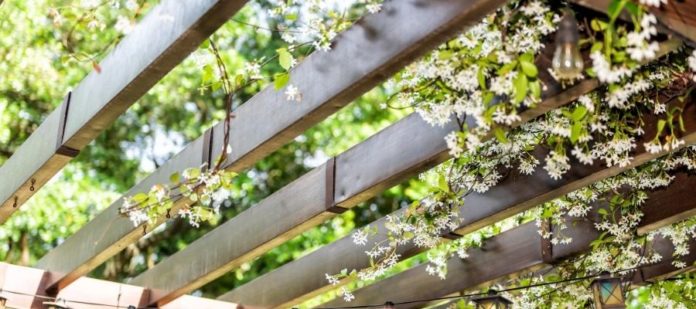You’ve probably seen a pergola before but may not have known what it was called. Pergolas are outdoor structures that can either stand on their own in a backyard or can be attached to the back of a house in the patio or deck area. They form a bare-bones roof framework in a latticework pattern. You can install a canvas cover on top of the pergola to get full coverage or leave it as it is to get a mixture of shade and less intense sunlight while sitting underneath, particularly if you plant vines such as wisteria or clematis to twine up the supports and across the roof. If you want to build a one for your yard, choose from the best materials to use for a pergola that we list here.
Vinyl
Vinyl is a type of plastic that people favor for outdoor structures because it is affordable and requires little maintenance aside from the occasional pressure wash. A vinyl pergola will have a clean, smooth appearance and comes in a variety of shades. If you want to cover a large amount of space, vinyl is advantageous because it is lightweight. You won’t need to reinforce its roof with too many additional columns even when you build it with wider dimensions. Using vinyl does limit you to preset pergola designs, though.
Pressure-Treated Wood
The best materials to use for a pergola inevitably include wood, particularly the pressure-treated variety. Wood boasts an attractive appearance because of its natural origin. Plastic can imitate it to a degree, but its color depth and grain texture are still distinguishable from that of plastic. The pressure treatment helps to lower the chance that the wood will rot or develop mold. However, it will still degrade more readily than the alternatives.
High-Density Polyethylene
High-density polyethylene, or HDPE, is another plastic that manufacturers can form into plastic lumber. Unlike vinyl, which is formed into premade kits for building pergolas, HDPE plastic lumber pieces can be cut and shaped to fit a unique design, similar to regular wood constructions. Moreover, plastic lumber is stronger than wood in several ways. It is not damaged by water or insects, and manufacturers can strengthen it by mixing fiberglass into its formula. It comes in several colors and can have grain-like patterns molded onto it.























